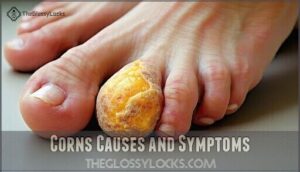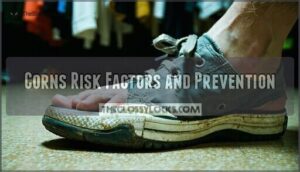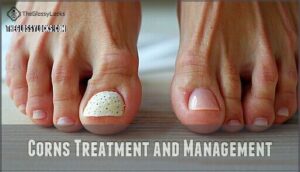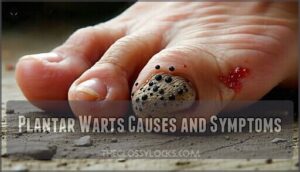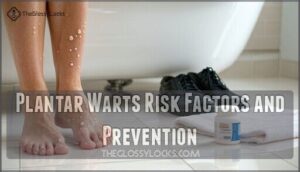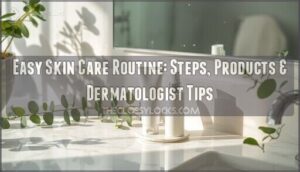This site is supported by our readers. We may earn a commission, at no cost to you, if you purchase through links.
 When you’re dealing with corn vs plantar wart confusion, look for these telltale signs: corns appear as smooth, yellowish bumps with hard centers, typically forming where your shoes rub against pressure points.
When you’re dealing with corn vs plantar wart confusion, look for these telltale signs: corns appear as smooth, yellowish bumps with hard centers, typically forming where your shoes rub against pressure points.
They’re your foot’s way of protecting itself from friction.
Plantar warts, however, show tiny black dots in the center and feel rough to the touch.
These viral invaders come from HPV you’ve picked up in locker rooms or pools.
Corns hurt when pressed directly, while plantar warts ache when you squeeze them from the sides.
The treatment approaches differ substantially, and knowing which one you’re battling makes all the difference.
The distinction between corns and plantar warts is crucial for effective treatment, and being able to identify the key characteristics of each, such as the presence of tiny black dots or a rough texture, can help you determine the best course of action to take, considering the viral invaders.
Table Of Contents
- Key Takeaways
- Corn Vs Plantar Wart
- What Are Corns
- What Are Plantar Warts
- Corns Vs Plantar Warts Treatment
- Preventing Corns and Plantar Warts
- Frequently Asked Questions (FAQs)
- How do I tell if I have a corn or plantar wart?
- Can I use corn remover on a plantar wart?
- What is the squeeze test for plantar warts?
- How do you remove a plantar corn?
- Can corns and plantar warts recur?
- Are corns and plantar warts painful?
- How long do plantar warts last?
- Are plantar warts contagious?
- Can footwear impact corns formation?
- Can corns or plantar warts become cancerous?
- Conclusion
Key Takeaways
- Look for visual clues to tell them apart – You’ll spot plantar warts by their rough texture and tiny black dots in the center, while corns appear as smooth, yellowish bumps with hard centers where your shoes create friction.
- Use the squeeze test for quick identification – You’ll feel sharp pain when squeezing a plantar wart from the sides, but corns only hurt when you press them directly from above.
- Address the root cause for effective treatment – You’ll need to reduce pressure and friction for corns by wearing proper footwear, while plantar warts require antiviral treatments since they’re caused by HPV infection.
- Prevent recurrence with targeted strategies – You’ll stop corns from returning by choosing well-fitting shoes and using protective padding, while you’ll prevent plantar warts by wearing protective footwear in public areas like pools and maintaining good foot hygiene.
Corn Vs Plantar Wart
You might notice a small, rough bump on your foot and wonder if it’s a corn or a plantar wart.
These two conditions look similar but have different causes, with corns forming from pressure and friction while plantar warts develop from a viral infection.
Definition and Characteristics
You’ve likely spotted a suspicious bump on your foot and wondered whether it’s a corn vs plantar wart.
These common skin growths look similar but have distinct characteristics.
A foot corn feels hard with smooth skin, while a plantar wart has a rough wart texture with black dots from tiny blood vessels.
| Feature | Corn | Plantar Wart |
|---|---|---|
| Surface | Smooth, hard skin | Rough, grainy texture |
| Color | Yellow/waxy appearance | Flesh-colored with black dots |
| Pain | Pressure-related discomfort | Sharp pain when squeezed |
Causes and Risk Factors
Understanding what causes these foot conditions helps you protect yourself from developing them.
Corns form when your shoes don’t fit properly, creating constant friction against your skin.
Plantar warts spread through HPV transmission from contaminated surfaces like gym floors.
Your risk increases with immune deficiency or foot deformities that change how you walk.
| Factor | Corns | Plantar Warts |
|---|---|---|
| Primary Cause | Poor shoe fit and friction | Human papillomavirus HPV infection |
| Risk Factors | Foot deformities, high heels | Immune deficiency, contaminated surfaces |
| Prevention Focus | Proper footwear selection | Avoiding barefoot contact in public areas |
Appearance and Physical Differences
Looking at these growths, you’ll notice distinct visual differences.
Plantar warts display a grainy appearance with characteristic black dots from broken blood vessels, while corns lack these pinpoints.
The difference between corn and wart becomes clear when examining surface texture and skin penetration depth.
| Feature | Plantar Wart | Corn |
|---|---|---|
| Surface Texture | Rough, grainy appearance | Smooth, waxy surface |
| Central Core | Black dots visible | Hard center, no dots |
| Color Variation | Flesh-colored with dark spots | Yellowish, lighter-colored |
What Are Corns
Corns are thickened areas of dead skin that form when your feet experience repeated pressure or friction from ill-fitting shoes or foot deformities.
You’ll recognize them as small, hard, raised bumps with a waxy appearance that typically develop on your toes, heels, or the balls of your feet, which is a result of repeated pressure or friction.
Corns Causes and Symptoms
Corns develop when your skin faces constant friction and pressure from ill-fitting shoes or foot deformities.
This repeated stress causes skin thickening as your body’s protective response.
You’ll notice several corn symptoms:
- Hard, raised bumps with a waxy, yellowish appearance
- Central core surrounded by dry, flaky skin
- Sharp, stabbing pain when walking or applying pressure
Corns Risk Factors and Prevention
Several factors increase your risk of developing corns.
Poor shoe fit creates friction and pressure points on your feet.
High heels and tight footwear force abnormal walking motion.
Foot deformities like bunions or hammer toes make certain areas more susceptible.
Prevention focuses on pressure reduction through proper footwear selection and protective padding to minimize friction between your skin and shoes.
Many find relief using specialized corn treatments, which can provide effective relief.
Corns Treatment and Management
When your corn starts cramping your style, you’ve got options.
Start with salicylic acid treatments to soften that stubborn bump. A pumice stone works wonders after soaking your feet – think of it as gentle sandpaper for skin.
Shoe inserts reduce pressure while moisturizing feet prevents cracking.
For added hydration, consider a deep conditioning treatment to soften skin. If home remedies fail, professional removal by a podiatrist offers quick relief.
What Are Plantar Warts
Plantar warts are viral skin infections caused by the human papillomavirus (HPV) that develop on the bottom of your feet.
You’ll recognize them by their grainy texture and small black dots in the center, which are actually broken blood vessels.
Plantar Warts Causes and Symptoms
Three specific HPV strains cause plantar warts through viral infection.
You’ll notice these contagious virus growths develop on your foot’s bottom, creating visual indicators like black pinpoints and rough texture.
Wart symptoms include pain when walking, especially if cluster formation occurs.
The pain threshold varies, but most people feel discomfort during weight-bearing activities.
Wart development disrupts normal skin patterns.
Lifestyle factors can also contribute to skin problems, such as increased cortisol levels.
Plantar Warts Risk Factors and Prevention
Your immune system plays a key role in fighting off the contagious virus that causes plantar warts.
Your body’s natural defenses are your first line of protection against stubborn plantar warts.
Understanding your risk helps you take protective measures against HPV exposure through direct contact with shared surfaces.
Here are five essential wart prevention strategies:
- Maintain excellent foot hygiene with daily washing and thorough drying
- Wear protective footwear in pools, gyms, and locker rooms
- Never share personal care items like towels, socks, or shoes
- Keep feet dry and change socks regularly
- Boost immune health through proper sleep, nutrition, and stress management
Plantar Warts Treatment and Management
Most plantar warts disappear without treatment, but persistent ones need professional intervention.
Salicylic acid solutions remain the first-line wart treatment, softening layers for easier removal. When that fails, cryotherapy freezes wart tissue with liquid nitrogen.
Cantharone use causes controlled blistering to lift stubborn warts. For resistant cases, consider effective plantar wart removal options.
Wart needling or surgical excision provides definitive wart removal options, which can be necessary for persistent cases.
Corns Vs Plantar Warts Treatment
You’ll find that both corns and plantar warts respond well to salicylic acid treatments, but their underlying causes require different approaches for complete healing.
While corns need pressure reduction through proper footwear and padding, plantar warts require antiviral treatments that target the HPV infection causing the growth.
Over-the-Counter Treatments
Drugstore shelves offer plenty of options for tackling both foot corn and plantar wart problems.
Salicylic acid treatments work best for both conditions, slowly dissolving thickened skin layers.
Compound W and similar brands provide reliable results within weeks.
Individuals can contract warts in places like public swimming pools.
| Treatment Type | Best For | How It Works | Treatment Duration | Notes |
|---|---|---|---|---|
| Salicylic Acid | Both corns & warts | Dissolves dead skin | 2-12 weeks | Most effective option |
| Freezing Methods | Plantar warts mainly | Destroys tissue | 1-4 treatments | Can cause temporary pain |
| Medicated Pads | Corns primarily | Softens callused areas | 1-3 weeks | Easy daily application |
| Cushioning Products | Both conditions | Reduces pressure | Ongoing use | Prevents further irritation |
| Combination Kits | Stubborn cases | Multiple approaches | 4-8 weeks | Higher success rates |
These over-the-counter wart removal and corn treatment options give you control over the healing process.
Padding options help reduce discomfort while active ingredients work, providing reliable results and a higher success rate with multiple approaches.
The use of salicylic acid is particularly effective, making it a most effective option for tackling these issues.
Prescription-Strength Treatments
When over-the-counter treatments don’t work, your doctor can prescribe stronger options.
Prescription topicals contain higher concentrations of salicylic acid for stubborn plantar warts. Dermatological treatment includes advanced cryotherapy options using liquid nitrogen. More intensive procedures like cantharidin application, wart needling, and surgical excision target resistant growths effectively.
Plantar warts are caused by the human papillomavirus, so addressing the virus is key.
| Treatment Method | How It Feels |
|---|---|
| Prescription Topicals | Like a gentle chemical peel |
| Cryotherapy Options | Cold sting, then numbness |
| Cantharidin Application | Mild burning sensation |
| Wart Needling | Quick pinch with anesthesia |
| Surgical Excision | Completely painless procedure |
Home Remedies and Self-Care
Many people turn to home treatments before visiting a doctor. You can soften corns with warm soaks, then gently file with a pumice stone.
Salicylic acid pads work for both conditions. Shoe inserts reduce pressure on corns. For warts, try the duct tape method or over-the-counter wart removal products.
Keep moisturizing feet daily. Many people find relief through therapeutic foot-care products.
| Treatment Method | Best For | How It Works |
|---|---|---|
| Warm Soaks + Pumice Stone | Corns | Softens skin, allows gentle filing |
| Salicylic Acid Pads | Both conditions | Dissolves thickened skin layers |
| Duct Tape Method | Plantar warts | Suffocates wart, aids removal |
| Shoe Inserts | Corns | Reduces friction and pressure |
| Daily Moisturizing | Both conditions | Prevents skin hardening |
Preventing Corns and Plantar Warts
You can prevent both corns and plantar warts by wearing properly fitting shoes, maintaining good foot hygiene, and avoiding direct contact with HPV in public areas like pools and gyms.
Simple steps like keeping your feet clean and dry, using protective footwear in shared spaces, and choosing shoes that don’t create pressure points will substantially reduce your risk of developing either condition.
Proper Footwear and Foot Care
Your shoes are your foot’s best friend or worst enemy. Choose well-fitting footwear that doesn’t squeeze or slide around.
Daily washing keeps feet clean and healthy. Trim nails straight across to prevent ingrown issues.
Cotton socks reduce friction and absorb moisture better than synthetic materials.
Regular foot inspections help you spot problems early, preventing painful pressure points that lead to corns.
Addressing calluses can also improve foot health, and a stainless steel rasp can be effective to prevent ingrown issues and maintain overall foot health.
Avoiding HPV Infection
HPV transmission happens through direct contact with infected skin or contaminated surfaces.
You can’t catch the virus from toilet seats, but shared items like towels increase risk.
Keep your immune health strong through proper nutrition and sleep, and practice good personal hygiene by washing hands frequently and avoiding touching warts.
Early detection helps prevent plantar wart spread to others, and maintaining immune health is crucial for overall well-being.
Reducing Friction and Pressure
You can prevent corn formation by minimizing friction and pressure on your feet.
Shoe inserts and orthotics benefits include redistributing weight away from problem areas.
Proper socks create a barrier between skin and footwear, and foot padding cushions high-pressure zones like toe joints and heel areas.
Pressure relief through well-fitted shoes stops foot problems before they develop into painful corns, and this is achieved by redistributing weight and minimizing friction.
Frequently Asked Questions (FAQs)
How do I tell if I have a corn or plantar wart?
Like detective work on your foot, you’ll spot key clues: plantar warts have tiny black dots and rough texture.
While corns appear as smooth, hard bumps without dots, typically forming where shoes rub.
Can I use corn remover on a plantar wart?
You can use corn remover on plantar warts since both contain salicylic acid.
However, wart-specific treatments work better because they’re designed to target the virus causing your plantar wart, not just dead skin.
What is the squeeze test for plantar warts?
Unlike gentle pressure that barely bothers a corn, you’ll squeeze the sides of a suspected plantar wart and feel sharp pain shooting through the growth.
Confirming it’s viral rather than just thickened skin.
How do you remove a plantar corn?
Soak your foot in warm water, then gently file the thickened skin with a pumice stone.
Apply salicylic acid patches or solutions daily.
Wear properly fitting shoes and use protective padding to prevent recurrence.
Can corns and plantar warts recur?
Like old-fashioned ailments that plagued our ancestors, both corns and plantar warts can return if you don’t address their root causes.
Corns reappear with continued pressure, while warts recur when HPV remains active in your system.
Are corns and plantar warts painful?
Both conditions can cause discomfort, but they differ in pain patterns.
Plantar warts typically hurt when you’re walking or standing, while corns cause pain from direct pressure or tight shoes rubbing against them.
How long do plantar warts last?
Plantar warts can last anywhere from several months to two years without treatment.
Your immune system will eventually fight off the HPV virus, but it’s often faster to treat them actively.
Are plantar warts contagious?
Absolutely, you’re walking around with a viral time bomb!
Plantar warts spread through HPV virus contact.
You’ll transmit them by sharing shoes, walking barefoot in public areas, or touching infected surfaces.
They’re highly contagious.
Can footwear impact corns formation?
Yes, your shoes directly cause corns by creating pressure and friction on your feet.
Ill-fitting footwear, high heels, and shoes without proper support force your skin to thicken protectively, forming these painful bumps.
Can corns or plantar warts become cancerous?
Neither corns nor plantar warts can become cancerous.
Corns are simply thickened dead skin from pressure, while plantar warts are benign viral infections.
Both remain non-cancerous growths that don’t transform into malignant tumors.
Conclusion
Understanding the corn vs plantar wart distinction empowers you to choose appropriate treatment and prevent complications.
Like Sherlock Holmes examining clues, you’ve learned to identify smooth, yellowish corns caused by friction versus rough, black-dotted plantar warts from HPV infection.
Remember that corns hurt with direct pressure while plantar warts ache when squeezed sideways.
Whether you’re dealing with mechanical friction or viral invaders, early identification leads to faster healing and better outcomes for your foot health.
- https://leadingedgepodiatry.com.au/corns-vs-plantar-warts-the-ultimate-guide/
- https://www.legacyfootcenter.com/blog/corns-calluses-plantar-warts-how-to-tell-the-difference
- https://www.podiatryandsportsmedicine.com/post/plantar-wart-vs-corn-whats-the-difference
- https://thefoothub.com.au/corn-vs-wart/
- https://denielfootandanklecenter.com/plantar-corns-and-warts-whats-the-difference/

